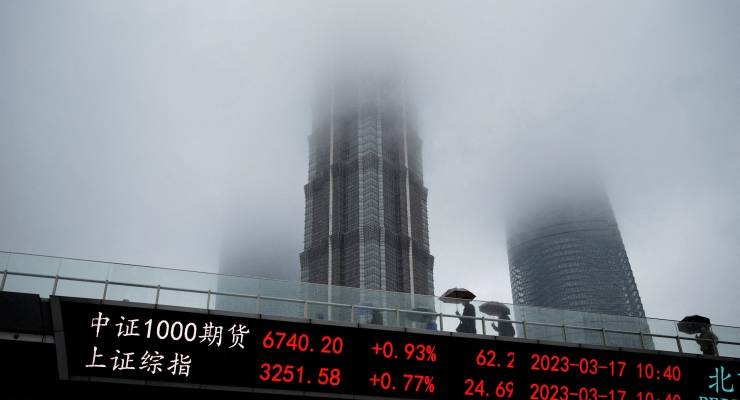
As Prime Minister Anthony Albanese prepares to visit Beijing, the enmity between China and the United States — Australia’s largest trading partner and strategic ally respectively — serves as an obstacle to Australia’s efforts to calm tensions and improve trade flows with China.
The diplomatic spat was inflamed in the past week after US Secretary of State Antony Blinken finally visited China to have a rare meeting with Chinese President Xi Jinping, the latest attempt by the two nations to improve their relationship. Blinken and Xi said the two sides had made progress, but only a day later another war of words erupted when US President Joe Biden called Xi a dictator.
The tension between the two risks blowback for Australia because of our increasingly close alignment with America under the AUKUS alliance and the Quad — the US, Australia, Japan and India — and with China warning in March that Australia’s decision to acquire nuclear submarines was a “path of error and danger”.
But strategic concerns may soon take second place to China’s stuttering economy. If this trend were to continue — and most signs are that it will — improved trade ties in smaller-ticket items such as wine, fruit and lobsters are unlikely to compensate for the impact an economic slump would have on Australia’s exports.
PM coy on date of visit
Despite sniping from Beijing about Australia’s strategic alliances, trade relations with China appear to be coming back on track. Markets for coal, barley and a range of agricultural products have reopened — although there are still blockages for wine and other goods.
China has decided to normalise things — well, a new normal at least — and is now the one waiting. It was recently reported that the roadblock to Albanese’s visit to China is Canberra rather than Beijing, with Chinese officials frustrated at his failure to lock down a date. Perhaps there is some sense of payback from Canberra after China froze all high-level contracts during the last four years of the Coalition government.
On Sunday, Albanese appeared to be once more warming up for a visit while still being coy about timing. “We’ll finalise the date at an appropriate time”, he said in an interview on the vehemently anti-Beijing Sky News about China. “The truth is that it is in Australia’s interest to export to China, but it’s also in China’s interest to receive those exports.”
He added that his next overseas trip would be to the NATO summit in Vilnius, Lithuania, in July. This is now becoming typical, as Albanese is more engaged with bigger global summits such as the G7 and NATO, neither of which Australia is a member of. He appears to be leaving the heavy lifting in China — and the region — to Foreign Affairs Minister Penny Wong and Trade Minister Don Farrell.
As well as trade, where an improving environment for citrus growers is the latest “win”, there is the pressing issue of journalist Cheng Lei and writer Yang Hengjun who have been detained in China for several years: “Cheng Lei … should be released and should be allowed to come home to Australia.”
It won’t help Albanese that Biden explicitly said Xi was unhappy about the Quad. Biden said he had previously told Xi the US was not trying to encircle China with the Quad: “He called me and told me not to do that because it was putting him in a bind.”
China’s economy loses steam
Yet only a week on and the comments by Biden and Blinken have been overshadowed by signs that China’s economy is in trouble again. It had bounced back earlier this year after three years of deterioration during the onerous lockdowns imposed by the government’s zero-tolerance COVID policy. That had cruelled China’s production capacity and supply lines to its export markets were hit by the global logistics crunch.
The unemployment rate for those aged 16 to 24 rose to a record 20.8% in May, and the jobless rate for all ages in cities rose by 5.2%. Industrial production rose by 3.5% in May from a year ago, slower than the 3.6% expected by a Reuters analysts poll, and retail sales rose by 12.7% in May — below expectations of 13.6%.
Last week the Chinese central bank reduced two key interest rates. While these are not as key as in countries such as Australia and the US because of China’s structure of capital controls and state ownership, analysts say they are a signal of policymakers’ concerns and appear to be a signal for more stimulus.
That’s often good news for Australia and its big-ticket export items, iron ore and coal — both metallurgical or coking — used to make steel and thermal coal for coal-fired power stations. Surging prices for both helped to boost receipts for the federal government and some states over the past year.
Prices have jumped in recent weeks on the hope of Chinese stimulus, but analysts have warned that an oversupply of steel will bring prices down, and the backdrop is the dangerously weakening Chinese property market which some believe will fester for years. Investment bank Goldman Sachs cut its forecast for iron ore for the current half-year from US$110 to US$90 a tonne, with the three-month target US$80 a tonne. Iron ore closed at US$113 a tonne on June 22.
If that’s not enough the Chinese economy is staring down the barrel of deflation, quite the opposite problem to that experienced in many Western nations. Falling prices mean lower consumer spending, with companies responding by slowing production, triggering possible rising unemployment as workers are laid off.
China’s headline manufacturing PMI has been below 50 for three straight months, indicating a contraction in factory gate prices — and has seen its worst performance for seven years. A commentary in the state-run China Daily said the outlook for exports was “grim” and called for swift and decisive action.
With growing economic pain in Australia and the West and dark warnings about a global recession, by the time Albanese and Xi meet, trade may not be top of the agenda.








PMI indexes vary greatly by whoever collects and publishes them. They all vary from positive for negative for any particular country in any given month. Chinas PMI may well be currently in the negative but the whole West is even deeper so. Another very selective fact cherry picking China doom and gloom article. There is nothing to cheer about. Our economy will be far worse off if China’s suffers.
I agree with you, as Chinese PMIs are an official statistic from the central statics bureau, they are quite likely to be made up and much worse in reality.
Well BB – ask Eric Abetz. I’m sure he’d be happy to give you a rundown :-).
Considering Ms betz has been out of parliament for a year now, you may wish to updated your understanding of contemporary Australian politics.